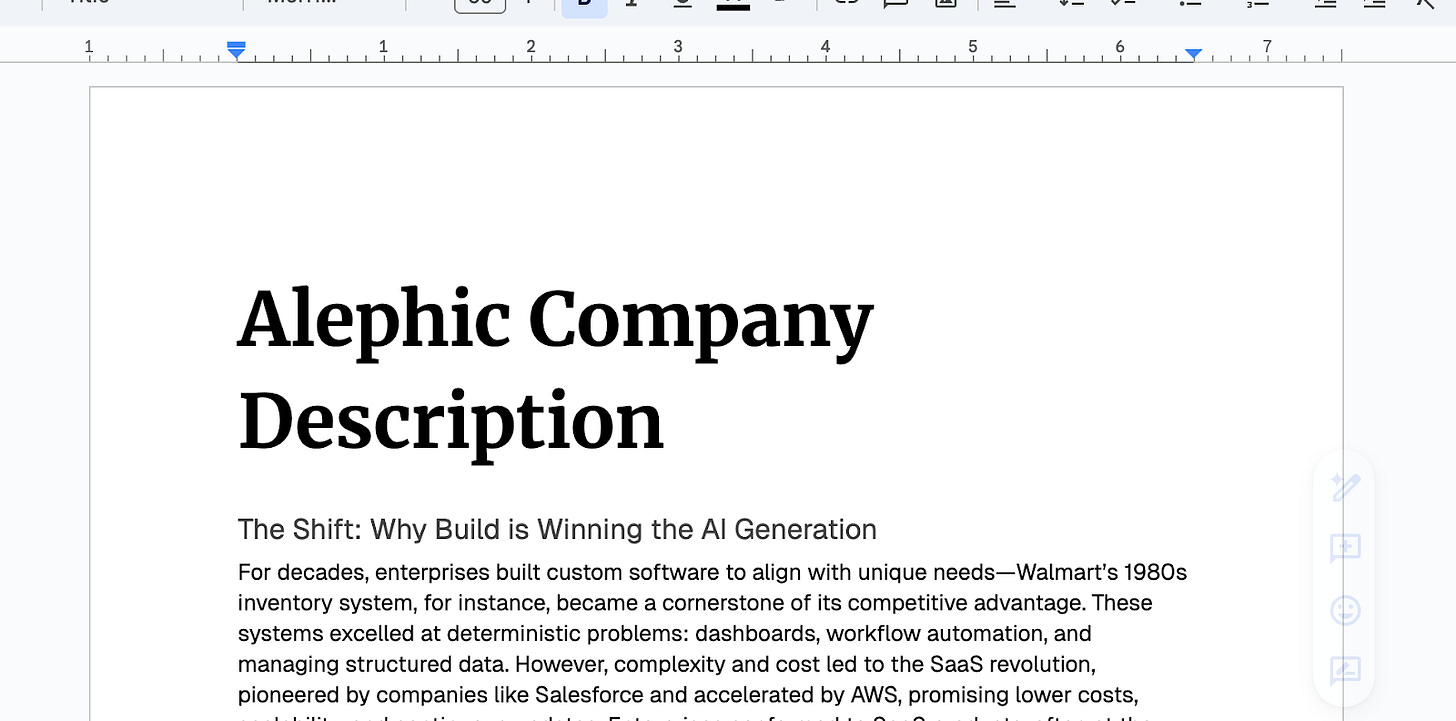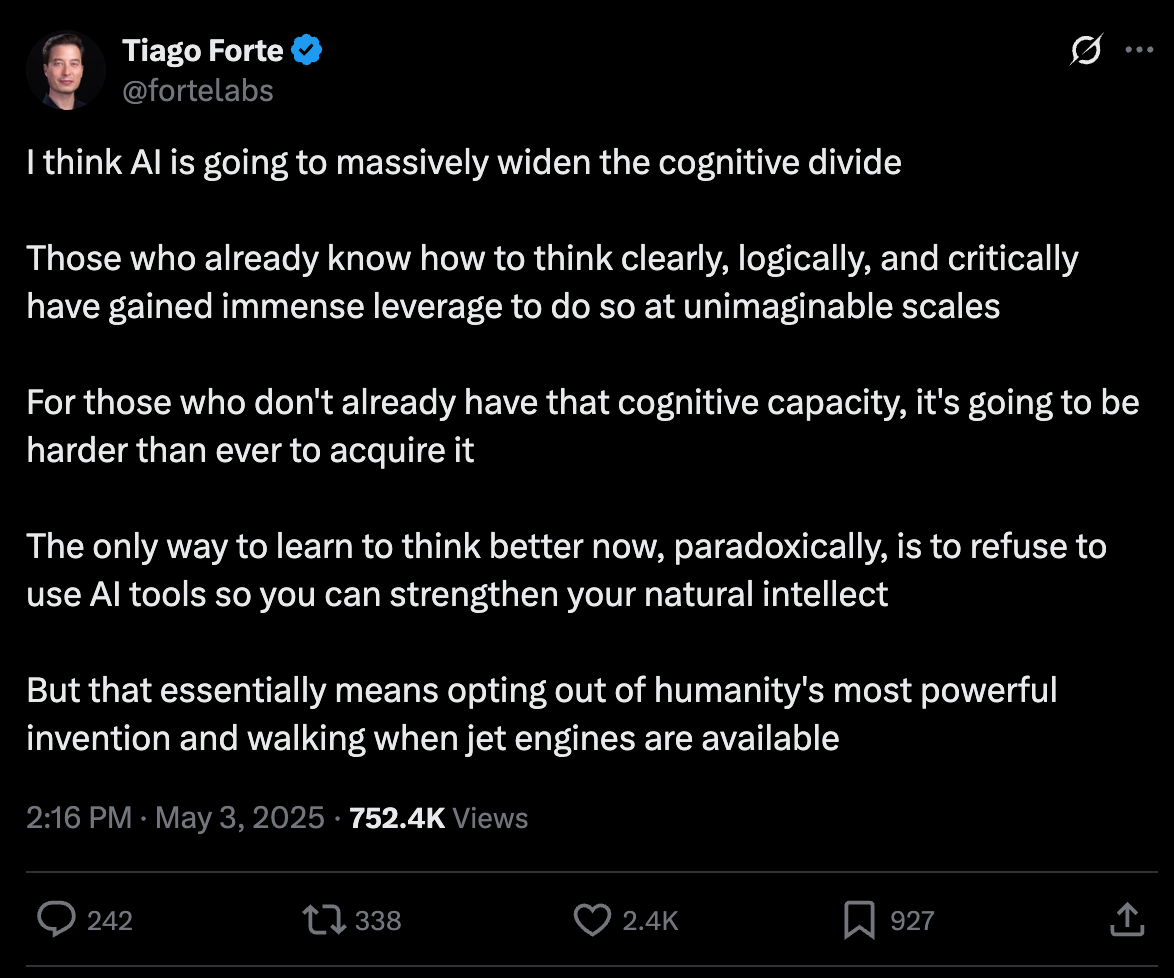Docs x AI // BRXND Dispatch vol 82
Plus, a few thoughts on Mark Zuckerberg’s Stratechery interview.
You’re getting this email as a subscriber to the BRXND Dispatch, a newsletter at the intersection of marketing and AI. We’re hosting our next BRXND NYC conference on September 18, 2025, and currently looking for sponsors and speakers. If you’re interested in attending, please add your name to the wait list. As space is limited, we’re prioritizing attendees from brands first. If you work at an agency, just bring a client along—please contact us if you want to arrange this.
Noah here. At the start of 2013, I gave a presentation to Percolate about our company values and vision for the year. By June, we had doubled our headcount to 60 people. When I referenced that presentation mid-year, I realized that half the people in the room had never heard it. That moment had a huge impact on my approach to company-building.
I became obsessed with documentation. As I told First Round Review in 2016, "nothing scales better or faster than words." The average adult reads two to three times as fast as they listen, and documentation is always available, while people aren't. This belief led us to create the "Day One" doc at Percolate—a comprehensive guide capturing our thinking and culture that every new hire received.
Now that I'm back in the saddle, building Alephic and scaling the team, I'm discovering something even more fascinating: documentation is evolving from a historical record into a foundational element for effectively working with AI. I wrote up a longer post over at the Alephic site, but I thought the relationship between AI and documentation part was worth sharing here as well. You can read the whole thing on Alephic.com.
AI-Native Documentation: Beyond Human Consumption
Traditional documentation optimizes for human readers, sequencing ideas for comprehension, providing context, and structuring knowledge for retrieval. AI-native documentation requires a fundamental shift in approach.
The Dual Audience Reality
For the first time, we must design documentation for two fundamentally different "readers":
Human consumers who navigate information linearly, rely on context, and benefit from narrative
AI systems that ingest information holistically, process patterns algorithmically, and learn from structured examples
This dual audience introduces new documentation requirements beyond the principles that guide human-centered documentation:
Enhanced precision over conversational flow
Structured examples over explanatory text
Pattern consistency over narrative coherence
Parameter explicitness over implied context
Documentation Types With Enhanced AI Value
Certain documentation types yield particularly rich training material for AI systems:
Brand guidelines and voice documentation: Enables AI to generate on-brand content by establishing explicit parameters around tone, terminology, and standards
Process documentation: Allows AI to suggest workflow improvements by mapping decision trees and identifying optimization opportunities
Strategic frameworks: Helps AI align recommendations with business goals by formalizing evaluation criteria and success metrics
Comprehensive exemplar libraries: Powers multi-shot prompting with diverse, high-quality examples at varying complexity levels
Building Documentation as Model Training Material
The most sophisticated AI implementations require documentation specifically designed to be ingested as training material:
1. Comprehensive Company Documentation as AI Context
Traditional brand documentation prioritizes concision and accessibility. AI-native documentation requires expanded depth and scope:
Compare:
Traditional brand page (Alephic Brand Page): ~500 words covering mission, beliefs, tenets, and voice in a concise format optimized for human consumption
AI-ready company description (6,000+ words): Exhaustively documents frameworks (Triangle Model, S.I.F.T. Methodology), fundamental beliefs (Build > License Thesis, Private Tokens Doctrine), working principles, talent frameworks, and engagement models
This expanded documentation feels excessive for human readers but provides the comprehensive context AI systems need to truly understand your organizational approach. It serves as training material that enables AI to generate content aligned with your strategic thinking rather than generic outputs.
2. Examples That Work for AI vs. Humans
Humans and AI systems learn differently through examples:
More is better for AI: Humans might understand a concept from 2-3 good examples. AI needs dozens or hundreds to recognize patterns across different situations.
Context matters: When documenting examples for humans, we focus on the example itself. For AI, we need to tag each example with information about when to use it, why it works, and how good it is.
Show the alternatives: Creating multiple versions of the same content with small differences (like changing the tone from formal to casual) helps AI understand what changes and what stays the same.
What Caught My Eye This Week (Luke)
Mark Zuckerberg’s new Stratechery interview is making waves. In it, he outlines Meta’s vision for fully automated, end-to-end ad campaigns powered by AI. Here’s the standout quote:
“We’re going to get to a point where you’re a business, you come to us, you tell us what your objective is, you connect to your bank account—you don’t need any creative, you don’t need any targeting demographic, you don’t need any measurement, except to be able to read the results that we spit out.”
Unsurprisingly, ad executives reacted with outrage, interpreting his remarks as a declaration of war on their profession. And to be fair, Zuckerberg didn’t do much to dispel that notion in the interview. But the vision of ad optimization he describes isn’t entirely new—Meta has been heading in this direction for years with tools like Advantage+.
More importantly, it’s worth considering who he’s actually talking to. Read between the lines, and this feels less like a message to big brands or agencies and more like a pitch to small and medium-sized businesses—the direct response advertisers who rely most heavily on Meta. These are the advertisers who prioritize efficiency, scale, and measurable outcomes over manual control. They value optimization in an advertising platform.
That’s not to say this shift won’t reverberate across the broader advertising industry. The uproar reminds me of a similar controversy last year, when Sam Altman predicted that AI would soon replace 95% of what marketers hire agencies to do. At the time, Noah wrote an excellent piece titled “Creativity vs. AI,” which addressed concerns about workforce reductions. It’s worth revisiting, because the core argument still resonates. He wrote:
“Ultimately, AI’s impact on creativity isn’t a simple story of replacement or revolution. It’s a nuanced collaboration between human expertise and machine capabilities. The most successful creatives will likely be those who learn to harness AI as a powerful tool in their process, amplifying their talents rather than replacing them.”
In related news, economists say that AI has not yet had a discernible impact on jobs or wages.
Interesting take: AI is going to massively widen the cognitive divide.
OpenAI is launching a shopping experience inside ChatGPT, with its eyes on the ~$17B affiliate marketing sector.
Also OpenAI’s new o3 model is disturbingly good at guessing where photos were taken.
Apple and Anthropic are collaborating on a “vibe coding” platform. Apple’s own AI coding assistant, Swift Assist, was supposed to launch last year but was derailed by hallucination problems—a symptom of the company’s deeper struggle to innovate from within, as it once reliably did.
Have you noticed ChatGPT acting a bit different lately? Friendlier, sycophantic even? You’re not alone. This is a good look at how AI developers engineer chatbots’ personalities and how this impacts their persuasiveness.
The classic hack of adding “Reddit” to your Google searches to get real, human answers may soon be obsolete, because Reddit is integrating AI Answers into its main search bar.
Why you should think of LLMs as weird computers: “If traditional computers are precision machines that struggle with fuzziness, LLMs are the inverse: fuzzy machines that struggle with precision (unless calling out to a traditional computer to do a precision task).”
New Jobs
Communications and Technology Strategy Director at Publicis Groupe, New York City (link)
Have a job you would like to share in the newsletter? Contact us.
If you have any questions, please be in touch. If you are interested in sponsoring BRXND NYC, reach out, and we’ll send you the details.
Thanks for reading,
Noah and Luke






